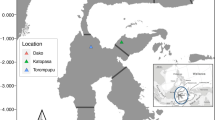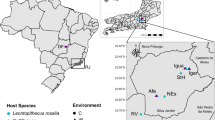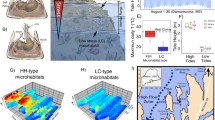Abstract
Background
The gut microbiota is an emerging frontier in wildlife research and its importance to vertebrate health and physiology is becoming ever more apparent. Reptiles, in particular snakes, have not received the same attention given to other vertebrates and the composition of their wild gut microbiome remains understudied. The primary goal of this work was to describe the cloacal microbiota of two Colubrids, the Eastern Gartersnake (Thamnophis sirtalis sirtalis) and the Northern Watersnake (Nerodia sipedon sipedon), and if their cloacal microbiota differed as well as if it did between a wetland and upland population of the former species.
Methods and results
We utilized next-generation sequencing of cloacal swabs—a non-destructive proxy for the gut microbiota. The cloacal microbiome of Eastern Gartersnakes (N = 9) was like those of other snakes being comprised of Proteobacteria, Bacteroidetes, and Firmicutes, while that of Northern Watersnakes (N = 6) was dominated by Tenericutes. Seven microbial operational taxonomic units (OTUs), all members of Proteobacteria, were shared among all individuals and were indicative of a core microbiome in Eastern Gartersnakes, but these OTUs were not particularly relevant to Northern Watersnakes. The latter had greater OTU richness than did Eastern Gartersnakes, and habitat did not have any apparent effect on the microbial community composition in Eastern Gartersnakes.
Conclusions
Our findings suggest host taxonomy to be a determining factor in the cloacal microbiota of snakes and that Tenericutes are associated with aquatic habitats. This is the first report to examine the cloacal microbiome of these species and provides a useful foundation for future work to build upon.



Similar content being viewed by others
Data availability
Cloacal microbiota data is available in online resource.
References
McFall-Ngai M, Hadfield MG, Bosch TCG et al (2013) Animals in a bacterial world, a new imperative for the life sciences. Proc Natl Acad Sci 110:3229–3236
Macke E, Tasiemski A, Massol F, Callens M, Decaestecker E (2017) Life history and eco-evolutionary dynamics in light of the gut microbiota. Oikos 126:508–531
West AG, Waite DW, Deines P et al (2019) The microbiome in threatened species conservation. Biol Cons 229:85–98
Colston TJ, Jackson CR (2016) Microbiome evolution along divergent branches of the vertebrate tree of life: what is known and unknown. Mol Ecol 25:3776–3800
Kohl KD, Brun A, Magallanes M et al (2017) Gut microbial ecology of lizards: insights into diversity in the wild, effects of captivity, variation across gut regions and transmission. Mol Ecol 26:1175–1189
Ren T, Kahrl AF, Wu M, Cox RM (2016) Does adaptive radiation of a host lineage promote ecological diversity of its bacterial communities? A test using gut microbiota of Anolis lizards. Mol Ecol 25:4793–4804
Jiang HY, Ma JE, Li J et al (2017) Diets alter the gut microbiome of crocodile lizards. Front Microbiol 8:2073
Yuan ML, Dean SH, Longo AV, Rothermel BB, Tuberville TD, Zamudio KR (2015) Kinship, inbreeding and fine-scale spatial structure influence gut microbiota in a hindgut-fermenting tortoise. Mol Ecol 24:2521–2536
Keenan SW, Engel AS, Elsey RM (2013) The alligator gut microbiome and implications for archosaur symbioses. Sci Rep 3:2877
Hill JG III, Hanning I, Beaupre SJ, Ricke SC, Slavik MM (2008) Denaturing gradient gel electrophoresis for the determination of bacterial species diversity in the gastrointestinal tracts of two Crotaline snakes. Herpetol Rev 39:433–438
McLaughlin RW, Cochran PA, Dowd SE (2015) Metagenomic analysis of the gut microbiota of the Timber Rattlesnake, Crotalus horridus. Mol Biol Rep 42:1187–1195
Colston TJ, Noonan BP, Jackson CR (2015) Phylogenetic analysis of bacterial communities in different regions of the gastrointestinal tract of Agkistrodon piscivorus, the cottonmouth snake. PLoS ONE 10:e0128793
Zhang B, Ren J, Yang D, Liu S, Gong X (2018) Comparative analysis and characterization of the gut microbiota of four farmed snakes from southern China. PeerJ 7:e6658
Tang W, Zhu G, Shi Q et al (2019) Characterizing the microbiota in gastrointestinal tract segments of Rhabdophis subminiatus: dynamic changes and functional predictions. MicrobiologyOpen 8:e789. https://doi.org/10.1002/mbo3.789
Ley RE, Hamady M, Lozupone C et al (2008) Evolution of mammals and their gut microbes. Science 320:1647–1651
Ley RE, Lozupone CA, Hamady M, Knight R, Gordon JI (2008) Worlds within worlds: evolution of the vertebrate gut microbiota. Nat Rev Microbiol 6:776–788
Hale VL, Tan CL, Niu K et al (2018) Diet versus phylogeny: a comparison of gut microbiota in captive colobine monkey species. Microb Ecol 75:515–527
Youngblut ND, Reischer GH, Walters W et al (2018) Host diet and evolutionary history explain different aspects of gut microbiome diversity among vertebrate clades. Nat Commun 10:1–15. https://doi.org/10.1101/484006
Barelli C, Albanese D, Donati C et al (2015) Habitat fragmentation is associated to gut microbiota diversity of an endangered primate: implications for conservation. Sci Rep 5:14862
Amato KR, Yeoman CJ, Kent A et al (2013) Habitat degradation impacts black howler monkey (Alouatta pigra) gastrointestinal microbiomes. ISME J 7:1344–1353
Huang BH, Chang CW, Huang CW, Gao J, Liao PC (2017) Composition and functional specialists of the gut microbiota of frogs reflect habitat differences and agricultural activity. Front Microbiol 8:2670
Sun B, Wang X, Bernstein S et al (2016) Marked variation between winter and spring gut microbiota in free-ranging Tibetan Macaques (Macaca thibetana). Sci Rep 6:26035
Hulse AC, McCoy CJ, Censky EJ (2001) Amphibians and reptiles of Pennsylvania and the Northeast. Comstock Publishing Associates, Ithica
Greenhalgh K, Meyer KM, Aagaard KM, Wilmes P (2016) The human gut microbiome in health: establishment and resilience of microbiota over a lifetime. Environ Microbiol 18:2103–2116
Videvall E, Song SJ, Bensch HM et al (2019) The development of gut microbiota in ostriches and its association with juvenile growth. Mol Ecol 2019:2653–2667
Zeglin LH, Wang B, Waythomas C, Rainey F, Talbot SL (2016) Organic matter quantity and source affects microbial community structure and function following volcanic eruption on Kasatochi Island, Alaska. Environ Microbiol 18:146–158
Caporaso JG, Kuczynski J, Stombaugh J et al (2010) QIIME allows analysis of high-throughput community sequencing data. Nat Methods 7:335–336
Wang Q, Garrity GM, Tiedje JM, Cole JR (2007) Naive Bayesian classifier for rapid assignment of rRNA sequences into the new bacterial taxonomy. Appl Environ Microbiol 73:5261–5267
Risely A (2020) Applying the core microbiome to understand host-microbe systems. J Anim Ecol 89:1549–1558
Oksanen J, Blanchet FG, Kindt R et al (2013) vegan: Community Ecology Package. R package version 2.5-7. https://CRAN.R-project.org/package=vegan
R Core Development Team (2019) R: a language and environment for statistical computing. https://cran.r-project.org/
Junior F, Rui S, Siqueira AK et al (2009) Comparison of wildlife and captivity rattlesnakes (Crotalus durissus terrificus) microbiota. Pesquisa Veterinária Brasileira 29:999–1003
Costello EK, Gordon JI, Secor SM, Knight R (2010) Postprandial remodeling of the gut microbiota in Burmese pythons. ISME J 4:1375–1385
Jho YS, Park DH, Lee JH, Cha SY, Han JS (2011) Identification of bacteria from the oral cavity and cloaca of snakes imported from Vietnam. Lab Anim Res 27:213–217
Coyte KZ, Rakoff-Nahoum S (2019) Understanding competition and cooperation within the mammalian gut microbiome. Curr Biol 29:R538–R544
Razin S, Yogev D, Naot Y (1998) Molecular biology and pathogenicity of mycoplasmas. Microbiol Mol Biol Rev 62:1094–1156
Brown DR (2002) Mycoplasmosis and immunity of fish and reptiles. Front Biosci 7:1338–1346
Palmer JL, Blake S, Wellehan JF Jr, Childress AL, Deem SL (2016) Clinical Mycoplasma sp. infections in free-living three-toed box turtles (Terrapene carolina triunguis) in Missouri, USA. J Wildl Dis 52:378–382
Ossiboff RJ, Raphael BL, Ammazzalorso AD et al (2015) A Mycoplasma species of Emydidae turtles in the northeastern USA. J Wildl Dis 51:466–470
Bano N, DeRae SA, Bennett W, Vasquez L, Hollibaugh JT (2007) Dominance of Mycoplasma in the guts of the Long-Jawed Mudsucker, Gillichthys mirabilis, from five California salt marshes. Environ Microbiol 9:2636–2641
Llewellyn MS, McGinnity P, Dionne M et al (2016) The biogeography of the atlantic salmon (Salmo salar) gut microbiome. ISME J 10:1280–1284
Gross R, Guzman CA, Sebaihia M et al (2008) The missing link: Bordetella petrii is endowed with both the metabolic versatility of environmental bacteria and virulence traits of pathogenic Bordetellae. BMC Genomics 9:449
Wu Y, Yang Y, Cao L et al (2018) Habitat environments impacted the gut microbiome of long-distance migratory swan geese but central species conserved. Sci Rep 8:13314
Videvall E, Strandh M, Engelbrecht A, Cloete S, Cornwallis CK (2017) Direct PCR offers a fast and reliable alternative to conventional DNA isolation methods for gut microbiomes. MSystems 2:e00132-e1117
Hale VL, Tan CL, Niu K et al (2016) Effects of field conditions on fecal microbiota. J Microbiol Methods 130:180–188
Choo JM, Leong LE, Rogers GB (2015) Sample storage conditions significantly influence faecal microbiome profiles. Sci Rep 5:16350
Videvall E, Strandh M, Engelbrecht A, Cloete S, Cornwallis CK (2018) Measuring the gut microbiome in birds: comparison of faecal and cloacal sampling. Mol Ecol Resour 18:424–434
Zhang Y, Simon SE, Johnson JA, Allen MS (2017) Spatial microbial composition along the gastrointestinal tract of captive Attwater’s prairie chicken. Microb Ecol 73:966–977
Berlow M, Kohl KD, Derryberry EP (2020) Evaluation of non‐lethal gut microbiome sampling methods in a passerine bird. Ibis 162:911–923
Artavia-León A, Romero-Guerrero A, Sancho-Blanco C, Rojas N, Umaña-Castro R (2017) Diversity of aerobic bacteria isolated from oral and cloacal cavities from free-living snakes species in Costa Rica rainforest. Int Sch Res Not 2017:1–9
Acknowledgements
We would like to thank Powdermill Nature Reserve for maintenance of the study locations and Ayana Scott-Elliston for assistance with microbial DNA extraction. Funding for this research was provided through a Southern Illinois University–Carbondale (SIUC) start-up grant to R.W.W.
Funding
Funding for this research was provided through a Southern Illinois University–Carbondale (SIUC) start-up grant to R.W.W.
Author information
Authors and Affiliations
Contributions
Conceptualization: JD, RW; Methodology: JD, LZ, RW; Formal Analysis and Investigation: JD and LZ; Writing—original draft preparation: JD; Writing—reviewing and editing: JD, WM, RW; Funding acquisitions: RW; Resources: WM; LZ, RW; Supervision: WM; LZ, RW.
Corresponding author
Ethics declarations
Conflicts of interest
The authors report no conflicts of interest.
Ethical approval
Animals were handled under Pennsylvania Fish and Boat Permit 02–0119 and under Southern Illinois Institutional Animal Use and Care Permit 21–016.
Additional information
Publisher's Note
Springer Nature remains neutral with regard to jurisdictional claims in published maps and institutional affiliations.
Supplementary Information
Below is the link to the electronic supplementary material.
Rights and permissions
About this article
Cite this article
Dallas, J.W., Meshaka, W.E., Zeglin, L. et al. Taxonomy, not locality, influences the cloacal microbiota of two nearctic colubrids: a preliminary analysis. Mol Biol Rep 48, 6435–6442 (2021). https://doi.org/10.1007/s11033-021-06645-x
Received:
Accepted:
Published:
Issue Date:
DOI: https://doi.org/10.1007/s11033-021-06645-x




